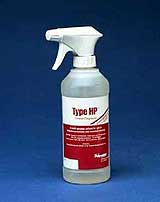Is your garage or workshop filled with aerosol cans of lubricants, cleaners, degreasers, and so forth. How about replacing them with more environmentally friendly and economical refillable spray cans?

Aerosol cans use carbon dioxide, propane, butane and other gases for pressurization. These greenhouse gases are suspected of contributing to global warming and smog. Also most used aerosol cans are tossed in the trash and thus eventually wind up in landfills where they take up scarce space. Also residual toxic fluids in the cans can leak out and eventually make their way into water supplies. Used partially filled aerosol cans may be considered hazardous waste by the EPA and many states.
Ounce-for-ounce, products in aerosol cans can be as much as twice as expensive as the same product sold in bulk quantities. Also you pay for the propellants in used in the aerosol cans. Most aerosols contain 10- to 15-percent propellant by weight.
There are two types of refillable bottles. First, there are metal bottles that are pressurized using compressed air at 80-to 200- pounds-per-square-inch pressure. As another benefit, compressed air is not flammable like many gases used to pressurize aerosol cans. Refillable metal bottles often resemble aerosol cans in both design and performance such as spray pattern. The other type are plastic bottles, like the ones used for many household products. Here a trigger produces the mist or stream.
The capacity of air-pressurized, refillable metal spray bottles range from 6 fluid ounces to a quart or so. Choose smaller bottles when you want to spray in hard-to-reach locations and larger ones when you can to avoid frequent filling. Nozzle extensions up to 12-inches in length are available for spraying in difficult locations.
Metal used for these refillable containers include aluminum, stainless-steel, brass, and steel. The material selected has to be compatible with the product being sprayed, though in most cases incompatibility is not a problem, especially if products are not stored in the containers for long periods. However, steel containers can rust when exposed to moisture. Therefore, make sure your compressor has a water removal device. Besides the container, you can also choose the spray nozzle, either for spray or stream. Adjustable nozzles for spray to stream are also available. Refillable spray bottles cost from $25 to $60 each, but can pay for themselves by reducing waste and though purchasing products in bulk quantities.
An example of compressed air charged, refillable bottles are the line of Sure Shot® sprayers offered by Milwaukee Sprayer Manufacturing. They come in two designs. MODEL "A" sprayers are metal with brass nozzles and corrosion resistant internal working parts. MODEL "A" sprayers with 32 oz. liquid capacity are available in either steel or brass, with either a painted or chrome plated exterior. Steel sprayers can be used with oil and solvent based materials while brass sprayers can also be used with water based materials. MODEL "B" sprayers are available in 7, 8, or 16 oz. aluminum canisters; 8 or 16 oz stainless steel canisters or 16 oz electroless nickel plated aluminum canisters. These closely resemble an aerosol can and use aerosol type valves and nozzles.
Since hand pumped, refillable bottles are made plastic, chemical compatibility is more of an issue. Therefore, chemically resistant plastic bottles and hand pumps should be used. Typically, they cost between $1 and $6. Check labels on product containers or with the supplier for possible incompatibility problems. If in doubt, put a small amount of product in container and let it sit for a few days to see if there is any deterioration.
Here are a few hints when using refillable spray bottles. While nozzles rarely clog, if they do, blow compressed air through both sides of the spray nozzle. As a preventative measure, clear spray nozzles with compressed air periodically, and keep dirt and grime out of the bottles when filling by using funnels with filters or screens. To void spills, use funnels and pumps when refilling.




